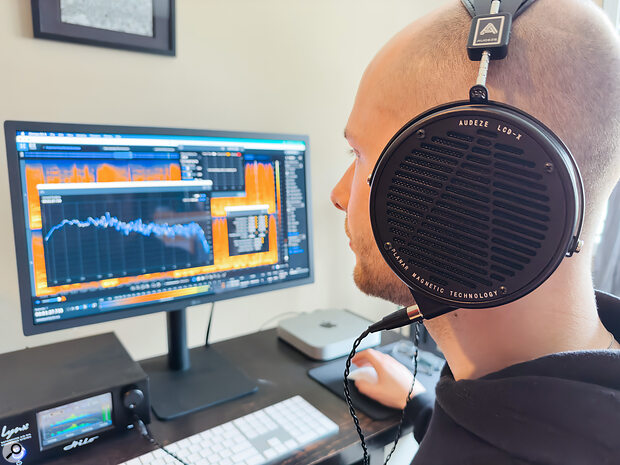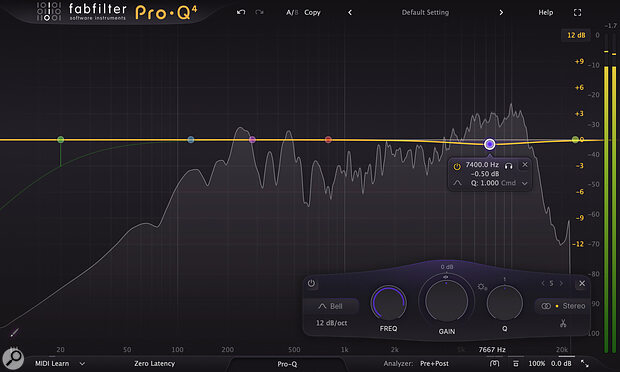 The author checking a master on his Audeze headphones. Sometimes a change of perspective reveals that a drastic EQ move wasn’t necessary after all!
The author checking a master on his Audeze headphones. Sometimes a change of perspective reveals that a drastic EQ move wasn’t necessary after all!
Mastering is not an extension of mixing. It requires its own skill set — and, above all, a philosophy of “first do no harm”.
We often think of mastering as applying the final touches. But sometimes, the most powerful move is doing nothing at all. Mastering, in my experience, is as much about knowing when to intervene as it is about technical finesse. By the time a mix reaches the mastering stage, most of the big decisions have been made. It’s tempting to think that one last tweak — the final five percent — might turn a good song into a great one. But often, the real job is resisting that urge. It’s vital to understand which tiny adjustments truly serve the music, and which might rob it of its soul.
Mastering teaches patience. We remind ourselves that our primary mission is not to fix the mix or showcase our own skills, but to facilitate the artist’s vision. Early in my career, I was eager to sculpt and polish every track. Over time, I learned that great mastering often looks like doing nothing at all. The best masters tend to disappear. The goal is a final product where the music speaks, not the engineer.
The Art Of Restraint
In mastering, less is almost always more. I follow a simple rule: change as little as necessary. If it isn’t broken, don’t fix it. Perhaps a mix has a boomy low end or an overly bright top, but sometimes it doesn’t. Sometimes the first instinct is to reach for a big EQ boost or heavy compression, but good mastering is more about subtle shifts. It’s like adjusting the colour palette of a film, rather than changing the edit itself.
In mastering, less is almost always more. I follow a simple rule: change as little as necessary. If it isn’t broken, don’t fix it.
I recall an early case with an indie ballad — a whisper‑quiet song about heartbreak and loss. The mix engineer gave me a delicate track with soft guitar strums and vocals so intimate you could hear the artist’s breath. It had a gentle beauty, but the vocalist’s breath was a tiny bit loud, and there was a faint hiss in the background. In the studio, I found myself turning up the volume to really feel the music, and that background noise became more apparent. The instinct was to apply a noise gate or offline noise reduction. But doing so would have snatched away the song’s intimacy. Instead, I took a much gentler approach: a surgical parametric cut on the loudest breaths, and a very light downward expansion that left plenty of breathing space. The final master still had a bit of ambience and grain, but without the distracting hiss.
 In mastering, less is often more. In this case, a cut of 0.5dB at 7.4kHz made all the difference.
In mastering, less is often more. In this case, a cut of 0.5dB at 7.4kHz made all the difference.
That moment taught me a lot about the final five percent. If I had cranked a broadband compressor or aggressively gated every noise, the track might have become technically cleaner, but it would have sounded sterile. The emotional resonance would have been lost. For that song, I learned that patience is more valuable than heavy‑handed editing. Trust the musical intent: sometimes an imperfection in the mix is part of the fabric of the song. But restraint isn’t always obvious in practice — especially when a mix arrives with more apparent flaws.
When Fixing Hurts More Than It Helps
Not all sessions are so subtle. Some mixes have obvious issues: a tilt towards harshness, muddiness in the mids, or an overbearing low end. The challenge is deciding when to step in. Remember that mastering is the final polish, not a remix. If something feels fundamentally off, ask if it might be a mix problem in need of revision.
One harsh lesson for me came with a rock track featuring a lead vocal from a vintage tube mic. It had...
You are reading one of the locked Subscribers-only articles from our latest 5 issues.
You've read 30% of this article for FREE, so to continue reading...
- ✅ Log in - if you have a Digital Subscription you bought from SoundOnSound.com
- ⬇️ Buy & Download this Single Article in PDF format £0.83 GBP$1.49 USD
For less than the price of a coffee, buy now and immediately download to your computer, tablet or mobile. - ⬇️ ⬇️ ⬇️ Buy & Download the FULL ISSUE PDF
Our 'full SOS magazine' for smartphone/tablet/computer. More info... - 📲 Buy a DIGITAL subscription (or 📖 📲 Print + Digital sub)
Instantly unlock ALL Premium web articles! We often release online-only content.
Visit our ShopStore.
